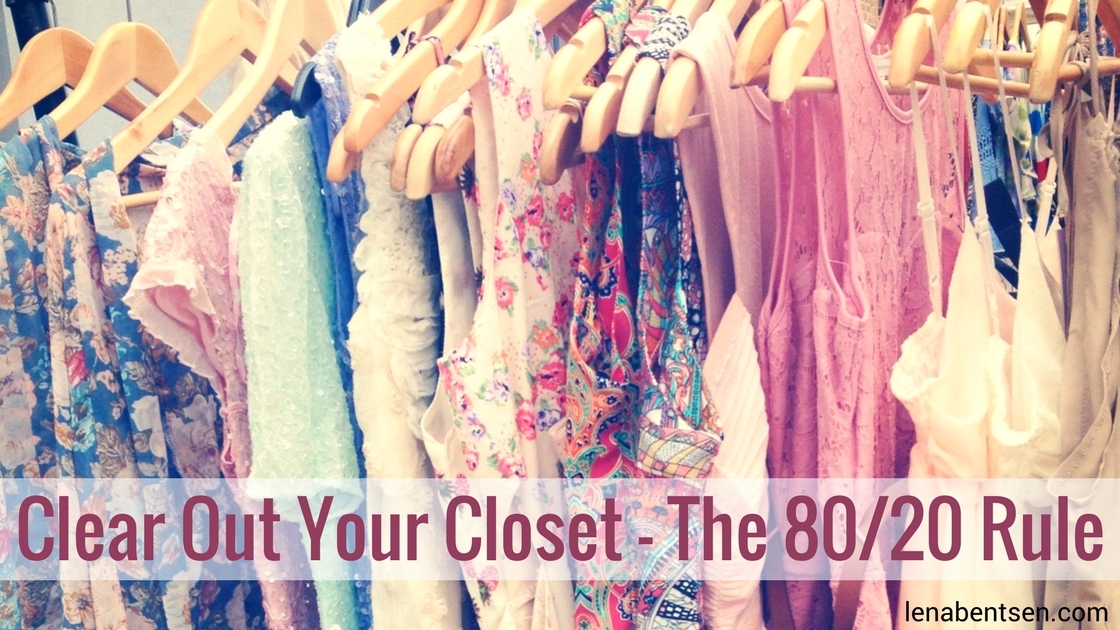
Are you tired of opening your wardrobe every day and not knowing what to wear because there is not enough clothing that feels right? Clear out your closet! If you would like to know how to distinguish between clothing to be kept and what needs to be removed, read on…
I would like to help you experience the beautiful feeling of freedom that comes from having a wardrobe holding only your very best clothing and accessories – your treasures. A wardrobe with only your treasures is a step towards Danish Hygge. Since 2005, I have helped numerous families get a unique home with spirit, charm and Danish Hygge by cleaning up, organizing and decorating with care and I share the method with you in my latest book, Enjoy Your Wardrobe. Here are some short tips from the book.
In a fairly ordinary wardrobe without a recent clean up, we can divide the 100% into the good ol’ 80/20 rule.
There are only two categories in your wardrobe.
Wearing/not wearing. That’s it.
1. Clothes you wear – that is the 20%
2. Clothes you do not wear – that is the 80%
As you know 80% is 4 times more than 20%. Obviously, it can be a bit difficult to find the golden 20% amongst the 100%! There might be many reasons for clutter in your wardrobe. Your overflowing closet might not be overflowing because you have kept clothing since your youth. It might be because you just have too much in relation to your usage. Nice, useful, modern clothing, but too much of it.
The 20%
The 20% is clothing you wear. Like, really wear. Not clothing that could be worn, but isn’t, because then we are dealing with the 80%. Be very aware of this difference. There is so much we can wear, but so little we actually wear — and even less we need, even though it is useful!
Clothing you wear, like really wear, can be divided into 2 categories:
– Clothing you wear all the time—depending on the season
– Clothing you rarely wear—special occasions
We have our favourite clothing. Clothing that we wear all the time—almost regardless of the season. In winter, a cardigan is worn over the blouse together with a scarf, and in summer the same blouse is worn, but together with something else. Clothing you rarely use might be nice for parties, or for occasions like a ski trip or when it is time to paint. It is still clothing you use, but rarely. Of course, it should not stop you from being critical once it is pulled out of the wardrobe.
That was the 20%. They are as such not a problem—except that they are hiding.
The 80%
The 80% is clothing you do not wear. Remember, we are talking about you. This is where you need to focus on clothing that you do not wear. The reason is completely irrelevant now. It simply concerns clothing you do not wear.
In the section for clothing you do not wear, there are only two categories as well:
1. Clothing that is useful
2. Clothing that is not useful
That’s it.
For example, have you spent too much money on a piece of clothing that turned out not to be your best friend? Well, the damage is done and you will not become richer, nor more beautiful by saving the magnificent piece one year more.
Useful clothing
Useful clothing is clothing that can be worn by others, but is not worn by you. It could be:
• Outdated clothing, but still nice and pretty.
• Somewhat expensive clothing when purchased, and now you are reluctant to get rid of it.
• Clothing that does not fit anymore. We will not get into why…!
• A lot of specific clothing, which means you cannot wear it all.
• Clothing you were tempted to buy, but have never worn. In the end, it turned out not being your style.
Not useful clothing
Not useful clothing is clothing that cannot or should not be worn by others. It could be:
• Ruined clothing that you haven’t repaired.
• Clothing that is no longer nice due to wear or a stubborn stain.
• Clothing that has been washed too many times—or maybe incorrectly.
• Clothing without its companion—such as socks.
• Smelly clothing.
Clothing, like so many other belongings in our lives, comes and goes. Though there seems to be a tendency for more to come than to go! And here is the pitfall: when we have too much clothing, we do not have a clear picture of what we have or what we need. This is a situation that can quickly lead to impulse buying here-and-there that you think you may need or believe will do wonders for your wardrobe.
To find out more, check out my latest book, Enjoy Your Wardrobe 🙂
